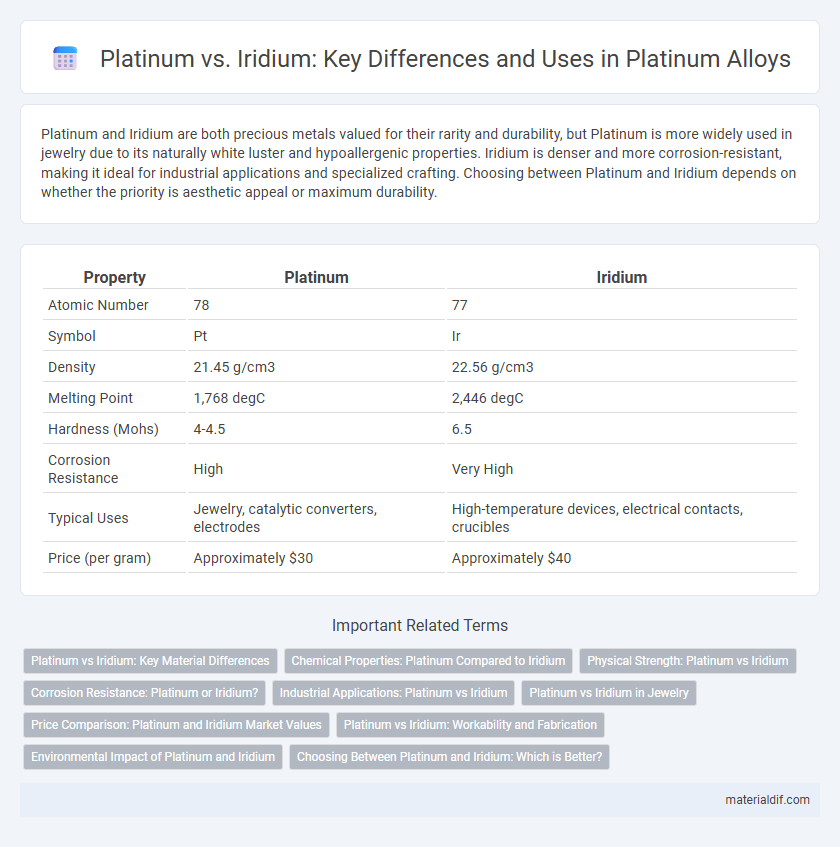Platinum and Iridium are both precious metals valued for their rarity and durability, but Platinum is more widely used in jewelry due to its naturally white luster and hypoallergenic properties. Iridium is denser and more corrosion-resistant, making it ideal for industrial applications and specialized crafting. Choosing between Platinum and Iridium depends on whether the priority is aesthetic appeal or maximum durability.
Table of Comparison
| Property | Platinum | Iridium |
|---|---|---|
| Atomic Number | 78 | 77 |
| Symbol | Pt | Ir |
| Density | 21.45 g/cm3 | 22.56 g/cm3 |
| Melting Point | 1,768 degC | 2,446 degC |
| Hardness (Mohs) | 4-4.5 | 6.5 |
| Corrosion Resistance | High | Very High |
| Typical Uses | Jewelry, catalytic converters, electrodes | High-temperature devices, electrical contacts, crucibles |
| Price (per gram) | Approximately $30 | Approximately $40 |
Platinum vs Iridium: Key Material Differences
Platinum and iridium differ significantly in density, hardness, and corrosion resistance; platinum has a density of 21.45 g/cm3, is softer with a Mohs hardness of 4-4.5, and offers excellent corrosion resistance, while iridium is denser at 22.56 g/cm3, much harder with a Mohs hardness of 6-6.5, and exhibits superior oxidation resistance at high temperatures. Both metals belong to the platinum group but platinum's malleability makes it ideal for jewelry and catalytic converters, whereas iridium's durability suits electrical contacts and high-temperature equipment. Platinum's better chemical stability in acidic environments contrasts with iridium's exceptional wear resistance, influencing their specific industrial applications.
Chemical Properties: Platinum Compared to Iridium
Platinum exhibits superior resistance to corrosion and oxidation compared to iridium, making it highly stable in various chemical environments. Both metals are transition elements with a strong affinity for forming complexes, but platinum's platinum group metal characteristics grant it more catalytic versatility. While iridium is harder and more brittle, platinum's malleability and ductility enhance its usability in industrial chemical processes and jewelry.
Physical Strength: Platinum vs Iridium
Platinum and iridium are both dense, precious metals, but iridium surpasses platinum in physical strength due to its higher hardness and greater resistance to wear and corrosion. Iridium's exceptional durability and melting point of about 2,446degC make it ideal for high-stress industrial applications, while platinum, with a melting point around 1,768degC, remains highly valuable for catalytic and jewelry uses. The superior physical strength of iridium is a key factor in its use in spark plugs, crucibles, and electrical contacts where resilience is critical.
Corrosion Resistance: Platinum or Iridium?
Platinum and iridium both exhibit exceptional corrosion resistance, but iridium outperforms platinum due to its higher resistance to oxidation and chemical attack, even in extreme environments. Iridium's ability to withstand aggressive acids and high temperatures makes it ideal for applications requiring long-term durability against corrosion. Platinum remains highly corrosion-resistant under most conditions but is more susceptible than iridium to chemical wear in highly oxidative or acidic environments.
Industrial Applications: Platinum vs Iridium
Platinum is extensively used in catalytic converters, chemical processing, and electronics due to its excellent corrosion resistance and catalytic properties, while iridium is preferred in high-temperature applications such as spark plugs and crucibles for its exceptional hardness and heat resistance. Industrial sectors leverage platinum for fuel cells and laboratory equipment, whereas iridium's durability makes it ideal for electrical contacts and aerospace components. Both metals are critical in specialized industries, with platinum dominating catalytic uses and iridium excelling in extreme environment applications.
Platinum vs Iridium in Jewelry
Platinum and iridium stand out in jewelry for their durability and rarity, but platinum is more popular due to its naturally white luster and hypoallergenic properties that suit sensitive skin. Iridium, often alloyed with other metals for strength, offers exceptional hardness but lacks the same widespread use or polished finish that enhances platinum's appeal in fine jewelry. Price differences also favor platinum, as its established market demand and ease of crafting maintain its status as a premium material for luxury rings and wedding bands.
Price Comparison: Platinum and Iridium Market Values
Platinum typically trades at a lower market value compared to iridium, driven by higher demand and more extensive industrial applications. Iridium's rarity and exceptional corrosion resistance contribute to its significantly higher price, often commanding multiples of platinum's cost per ounce. Market fluctuations are influenced by automotive catalyst demand for platinum and specialized electronics and aerospace uses for iridium.
Platinum vs Iridium: Workability and Fabrication
Platinum exhibits superior workability compared to iridium due to its lower melting point of 1,768degC and greater malleability, making it easier to shape and fabricate into intricate designs. Iridium, with a higher melting point of about 2,446degC and exceptional hardness, is more challenging to process, requiring specialized high-temperature techniques and tools. These differences in physical properties significantly influence their selection in applications where detailed craftsmanship or high durability in extreme environments is critical.
Environmental Impact of Platinum and Iridium
Platinum and iridium both serve critical roles in catalytic converters, but platinum generally has a lower environmental impact due to its higher abundance and more efficient recycling processes. Iridium, being rarer and more energy-intensive to mine and refine, tends to have a greater carbon footprint and resource depletion effect. The environmental sustainability of platinum is enhanced by its widespread use and development in green technologies such as fuel cells and hydrogen production.
Choosing Between Platinum and Iridium: Which is Better?
Platinum offers excellent corrosion resistance and superior electrical conductivity, making it ideal for catalytic converters and jewelry, while iridium excels in extreme durability and high melting point applications such as spark plugs and crucibles. Choosing between platinum and iridium depends on the specific requirements of heat resistance, corrosion prevention, and mechanical strength. Platinum is generally preferred for aesthetic and chemical stability, whereas iridium is better suited for environments demanding exceptional hardness and thermal endurance.
Platinum vs Iridium Infographic

 materialdif.com
materialdif.com